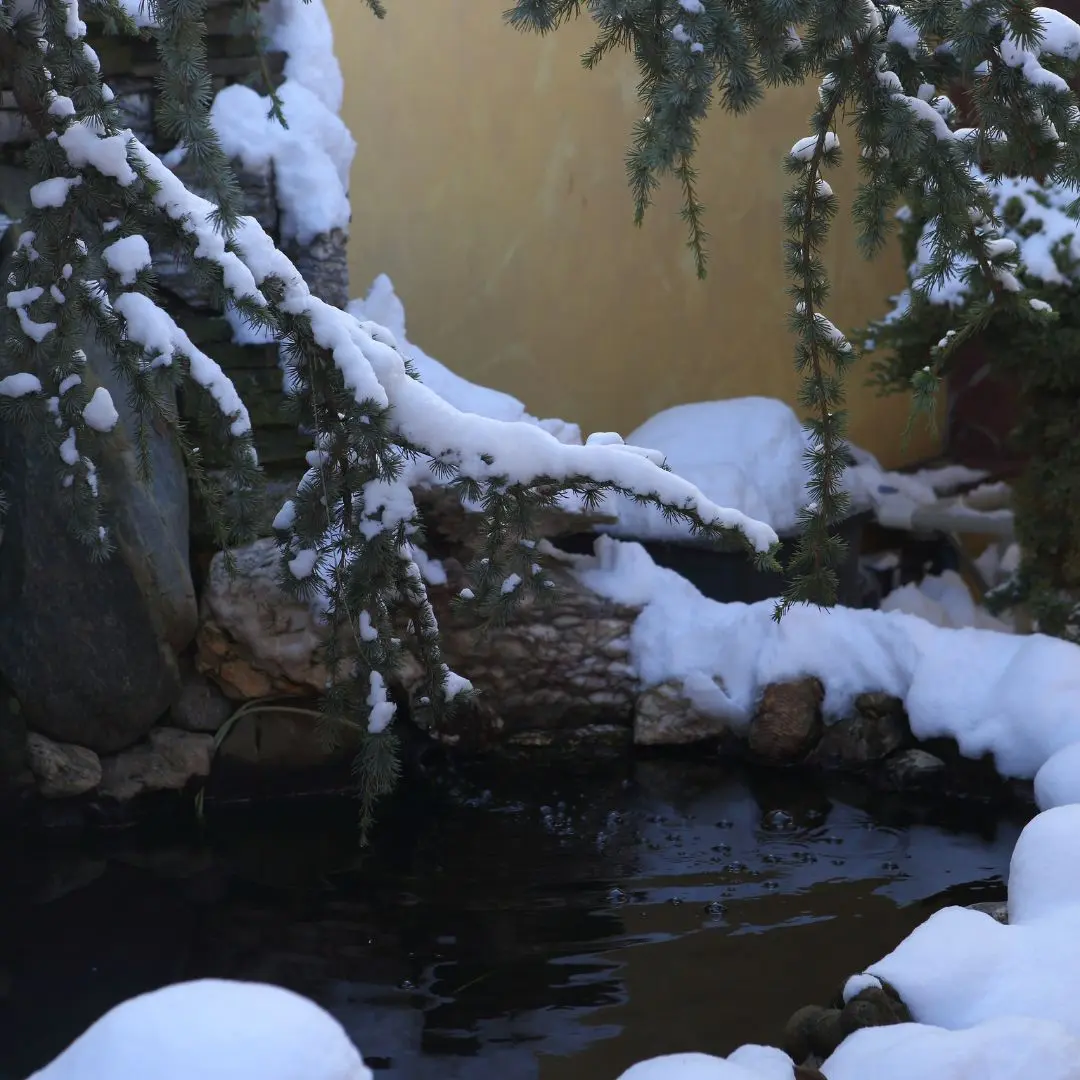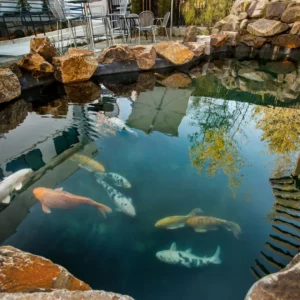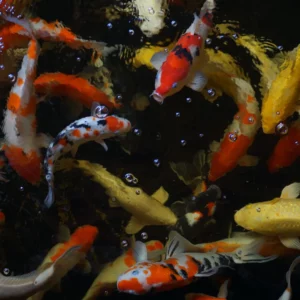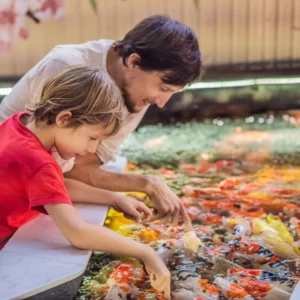Although Koi fish are relatively easy to care for, seasonal changes require extra care. And winter is no exception!
Most Koi fish can withstand lower temperatures but are vulnerable to potential water freezing.
In this article, we’ll talk about the best ways to take care of your Koi fish in winter and how to safely move your Koi inside in case of extreme temperature drops (if you decide to do so).
Table of Contents
What Happens to Koi Fish In Winter?
Here’s what happens to Koi during winter and why it’s important to take extra care of them during this time:
- Slowdown mode: Their metabolism slows down significantly as the water temperature drops. They become less active, spending most of their time near the bottom of the pond where the water is warmest.
- Living off fat reserves: Koi build up fat reserves during the warmer months, which they rely on for energy during winter when they stop eating altogether.
- Immune system on standby: Their immune system also slows down, making them more susceptible to diseases.
Can Koi Fish Survive The Winter?
Koi fish can survive the winter, but it depends on several factors, including:
- Climate: If you live in a region with mild winters where the pond doesn’t freeze solid, your koi will likely be fine without special care. However, if your area experiences harsh freezes, you must take steps to protect your fish.
- Pond depth: Deeper ponds (at least 4 feet) naturally retain more heat at the bottom, providing a refuge for the fish even if the surface freezes. Shallow ponds may require heating or other measures to prevent complete freezing.
- Koi’s health and age: Younger or weaker fish may be more susceptible to cold stress and may benefit from warmer water.
How cold is too cold for koi fish?
At 32°F (0°C), water freezes, posing a serious threat to koi. This is generally considered the “too cold” point.
Minimum Safe Temperature
- Ideal range: Koi thrive in water temperatures between 59°F – 77°F (15°C – 25°C).
- Tolerable range: They can survive in temperatures as low as 39°F – 50°F (4°C – 10°C), but only for short periods and with good health.
So consider those temperature guidelines, as maintaining the ideal temperature can significantly impact the health of your Koi and affect their lifespan.
Should You Heat The Pond In Winter?
Let’s take a look at the common pros and cons of heating your Koi pond in winter:
Pros:
- Protects your koi from freezing: This is the most important benefit, especially in areas with harsh winters.
- Maintains their health and activity: Warmer water helps koi maintain their metabolism and immune function, reducing the risk of disease.
- Extends the pond season: You can enjoy your koi year-round with a heated pond.
- More natural environment: Koi have adapted to survive in cold temperatures, and not heating the pond can mimic their natural environment.
Cons:
- High cost: Heating a pond can be expensive, especially if you have a large pond or live in a cold climate.
- Risk of equipment failure: Pond heaters can malfunction, so it’s important to have a backup plan in case of a breakdown.
- Risk of fish loss: Koi become less active, and their immune system weakens in cold water, making them more susceptible to disease.
So, if the pond freezes solid, your koi may not survive due to drastic temperature changes.
Ultimately, the decision of whether or not to heat your koi pond is up to you. Consider the pros and cons carefully, as well as your specific circumstances.
How to Take Care of Your Koi Fish In Winter?
- Use a De-icer to Prevent Freezing
- Use Water Pond Heaters
- Use Solar Blankets
- Protect Pond Equipment from freezing
- Maintain Aeration
- Monitor Water Quality
- Adjust winter feeding for your koi
- Or, Move Your Koi Inside During Winter
Use a De-icer to Prevent Freezing
A de-icer acts as a tiny sunlamp for your Koi fish pond, strategically preventing (or at least mitigating) complete ice formation.
Here’s how it works:
A quality de-icer can help maintain an open water area. By generating heat, the de-icer creates a “breathing hole” in the ice, ensuring vital gas exchange and preventing harmful gas buildup.
The heat radiates downwards, creating pockets of warmer water in the depths. This provides a refuge for your Koi and encourages more circulation/movement.
Access to open water and warmer zones alleviates stress on your fish, boosting their immune system and overall health.
However, keep in mind that not all de-icers are created equal. Selecting the right one depends on your pond’s size, depth, and desired ice-free area. Here are a few key considerations:
- Wattage: Higher wattage de-icers generate more heat, ideal for larger ponds or colder climates.
- Submersible vs. Floating: Submersible de-icers heat the water directly and are concealed while floating ones are easier to remove but less efficient.
- Air vs. Electric: Air bubblers are quieter and energy-efficient but may not prevent complete freezing in harsh conditions. Electric de-icers are stronger but require proper protection of GFCI (ground-fault circuit interrupter).
Here are a few tips on how to get the most out of your de-icer:
- Position the de-icer in the deepest central area of the pond to create a larger warm zone.
- Tilt the de-icer slightly towards the surface to promote heat circulation and gas exchange.
- Regularly remove debris and ice buildup around the de-icer to ensure optimal heat transfer.
Here are some deicers you may want to check out:
Use Water Heaters
Submerged in the water, water heaters can help you maintain a specific temperature ideal for Koi fish, aiding in their hibernation process. This prevents water from freezing solid, promotes oxygen circulation, and reduces stress on your fish.
Before you choose the heater for your Koi pond, make sure to consider:
- The type:
- Submersible: Most commonly, directly heats the water where your fish reside.
- Floating: Easier to install and remove, but less efficient at heating deeper water.
- In-line: Installed within the plumbing, ideal for large ponds or complex filtration systems.
- Placement and operation:
- Position the heater in the deepest part of the pond for optimal heat distribution.
- Submerge it completely and ensure proper grounding and GFCI protection.
- Set the thermostat to maintain a temperature between 15°C to 25°C (59°F to 77°F).
- Monitor the water temperature regularly and adjust the setting as needed.
And here are some valuable tips:
- Calculate the pond’s volume and depth to determine the required wattage.
- Consider the coldest winter temperatures your region experiences.
- Opt for a heater with an adjustable thermostat for precise temperature control.
Note: Keep in mind that water heaters may be less effective in a large pond compared to an indoor aquarium. So don’t forget about other tools, such as de-icers!
Use Solar Blankets
These lightweight, bubble-wrapped covers float on the surface, trapping precious heat generated by the sun. They also prevent excessive ice formation, ensuring gas exchange and access to deeper, warmer water for your koi.
I’ve listed some important considerations to help you find the right solar blanket for your pond friends.
- Types:
- Single-bubble blankets: Affordable, effective for mild winters and smaller ponds.
- Double-bubble blankets: Extra insulation for colder climates and larger ponds.
- Triple-bubble blankets: Maximum insulation for extreme cold, ideal for deep ponds.
- Installation:
- Unroll the blanket over the pond surface, ensuring it’s slightly larger than the water body.
- Secure the edges with weights or netting to prevent wind flapping and tearing.
- Leave a small gap near the pump or skimmer for water circulation and gas exchange.
- Maintenance:
- Periodically remove leaves and debris that accumulate on the blanket’s surface.
- Check for tears or punctures and repair them promptly.
- Store the blanket indoors in a cool, dry place when winter ends.
To help you out, here are some quality ones to check out:
- Blue Wave NS420 12 mil Solar Blanket
- Amylove 7 ft x 7 ft Bubble Cover
- Thermal Solar Blanket by Gekufa Store
Note: Don’t forget to leave a breathing hole and add aeration system.
Protect Pond Equipment from freezing
Don’t forget your pond’s hardworking equipment! Pumps, filters, and skimmers need winter protection too. You should wrap them in insulated blankets (or similar material) to prevent freezing and potential damage.
Remember: Malfunctioning equipment can indirectly affect your koi’s well-being during winter by not providing enough warmth, oxygen, etc.
But don’t worry – I’ve listed some important guidelines for equipment coverage to help you out.
- For pumps: Due to possible freezing, it’s not uncommon for most water pumps to get frozen. To avoid this, disconnect and drain hoses/pipes.
However, suppose you have a high-quality, durable pump that can work under extreme conditions. In that case, you can always wrap it in an insulated blanket or sheet or build a wooden shelter (preemptively, of course).
Pro tip: You should apply non-toxic antifreeze to pumps before storing them indoors.
- For filters: Clean the filter thoroughly before winter to remove debris and potential ammonia buildup. Wrap the filter with an insulated blanket or create a simple frame with plywood and insulation. Ensure proper ventilation to prevent moisture buildup inside the shelter.
- Skimmers: Disconnect and store the skimmer basket indoors if not in use. For winter operation, wrap the skimmer body in an insulated blanket.
Pro tip: Regularly clear ice and debris from the skimmer opening to maintain water flow.
Maintain Aeration
Even under ice, your koi need oxygen to breathe. An air pump with diffusers near the pond’s bottom keeps the water circulating and prevents harmful gas buildup.
Note: The rising bubbles also create a small open area in the ice, allowing for gas exchange.
Be sure to choose an air pump with sufficient power for your pond size and depth.
Pro tip: For easier, hassle-free regulation, consider a model with the timer function as it will automize the work.
Pond aeration systems recommendations:
Here are some important tips for maintaining aeration:
- Place diffusers strategically near the bottom of the pond to create water circulation throughout.
- Ensure adequate bubble distribution across the pond’s surface.
- Never let the entire water surface freeze over, as gas exchange needs an open area.
- Place the air pump in a sheltered location, protected from the elements.
- Regularly inspect and clean the airlines and diffusers to prevent clogging.
Monitor Water Quality
Maintaining your koi pond’s water quality through small, frequent water changes.
By mimicking the natural water flow, you remove pollutants and prevent harmful buildups, creating a healthy and vibrant ecosystem for your beloved koi.
But why small, frequent changes? Can you change all of the water?
Imagine a large water change as a drastic overhaul. While effective, changing all the water from the pond can shock your fish when you return them to new water. This kind of change also destabilizes the delicate biological balance within the pond.
On the other hand, here are the benefits of performing water changes:
- Gradual Reduction of Pollutants: Regular, small-scale removals prevent waste products like ammonia and nitrite from reaching harmful levels, protecting your koi’s health.
- Minimized Stress: Smaller changes keep water parameters closer to existing levels, avoiding the stress fish experience with large fluctuations.
- Stable Ecosystem: Consistent removal of organic matter and nutrients encourages beneficial bacteria to thrive, maintaining a stable pond environment.
- Reduced Maintenance Burden: Smaller, more frequent changes are easier to manage than infrequent large ones, allowing you to stay on top of water quality.
However, it’s mandatory to understand that there’s no perfect solution to this practice. So the ideal frequency and volume of water changing depend on several factors like:
- Pond Size: Larger ponds naturally require more frequent changes than smaller ones.
- Koi Load: More fish generate more waste, necessitating more frequent removal.
- Filtration Efficiency: Effective filters reduce the burden on water changes but don’t eliminate the need altogether.
- Seasonality: Warmer months usually increase fish activity and decomposition, requiring more frequent changes.
As a general rule of thumb, try aiming for weekly changes of 10 to 20% of the total pond water – this removes accumulated waste without upsetting the ecosystem.
For your convenience, I’ve listed some valuable tips for changing water in your Koi pond:
- Use aged tap water or dechlorinated pond water to replace the removed water. Avoid introducing chlorine or chloramines, which are harmful to fish.
- Siphon water from various pond areas, especially near the bottom, where debris and waste accumulate.
- Clean your filter media with the removed water, where much of the waste gets trapped.
- Don’t forget to monitor water parameters like pH, ammonia, nitrite, and nitrate after each change, and adjust your approach if necessary.
Here are some water testing kits:
- API FRESHWATER MASTER TEST KIT
- Umlecoa 10 in 1 Aquarium Ammonia Test Kit
Adjust winter feeding for your koi
Your koi’s metabolism slows down significantly in winter, and they enter a semi-dormant state. Feeding your Koi fish during this time can lead to digestive issues and water quality problems. Resist the urge to toss them treats, and let them utilize the fat reserves they built up during the warmer months.
On the other hand, they may require some food if they’re not hibernating. For instance, you should only feed your Koi during winter if the water temperature exceeds 50°F/10°C – you can offer small amounts of easily digestible, high-protein food.
Or, Move Your Koi Inside During Winter
Acclimate Your Koi Gradually
Potential shock is one of the biggest risks of moving your Koi from the pond to the aquarium. This process can easily scare the Koi, make them uncomfortable, and cause stress.
To avoid those issues, help your Koi to acclimate (adapt to new temperature) slowly over several days. Here are the necessary steps to take:
- Fill a large container with pond water.
- Float it inside the aquarium, secured and partially submerged.
- Gradually add aquarium water to the container each day, mixing the temperatures.
- Once the temperatures are equalized, gently net your koi and release them into the aquarium.
Quarantine Adequately
Even the healthiest pond fish can sometimes carry parasites or pathogens. Set up a separate quarantine tank for the koi to protect your other aquarium inhabitants.
Be sure to follow these steps:
- Use a dedicated tank and equipment for the quarantine period, approximately at least four to five.
- Maintain the same, or at least similar, water parameters as the aquarium but avoid introducing plants or decorations.
- Monitor the koi closely for signs of illness, such as lethargy, loss of appetite, or unusual fin movements.
- Treat any identified parasites or diseases promptly with veterinarian-approved medication.
Provide Enough Space
Typically, indoor setups often have limited space available. For example, there should be a minimum of 150 gallons of water per koi in most ponds, significantly more than most beginner koi owners expect.
However, indoor holding tubs can be smaller as they are temporary. This is why having the largest tank/aquarium is critical. By providing enough water, you’ll help reduce the stress on your koi from the environmental change.
Install the Filtration System
If you have very large fish in a smaller pond, they are at a very high risk of experiencing deadly ammonia spikes.
To ensure the survival of your fish during this transition, the best thing you can do is bring their filter media along. Placing these filter media in the indoor holding tank’s filter can prevent a spike in ammonia levels and make your fish much happier.
My Senior Paws is a participant in the Amazon Services LLC Associates Program, an affiliate advertising program designed to provide a means for sites to earn advertising fees by advertising and linking to Amazon.com. We also participate in other affiliate programs which compensate us for referring traffic.




